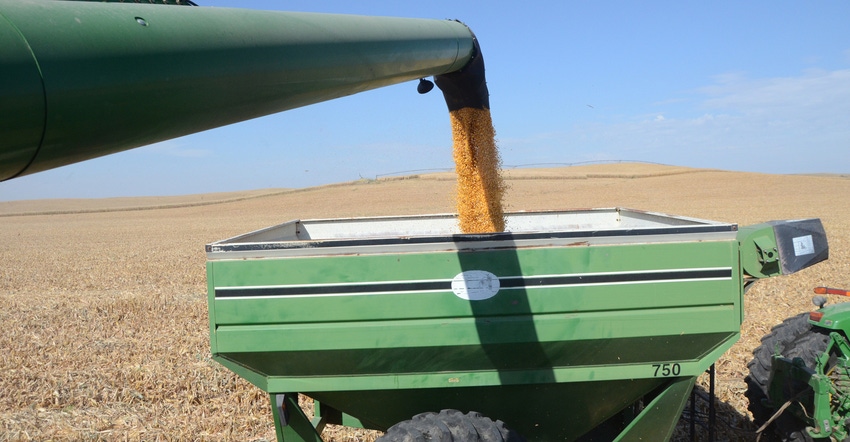May 14, 2019

A new report by the Nebraska Farm Bureau details the strong connection between the threat of U.S. -imposed tariffs on trade partners and the loss of hundreds of millions of dollars in Nebraska agriculture exports in 2017.
The Nebraska Agriculture and International Trade report uses the most current USDA trade data to identify the 2017 value of Nebraska agriculture exports on a per-commodity, per-county and per-farm and ranch basis. In doing so, the report details the sensitivity of agriculture markets and Nebraska exports to negative trade and tariff talk.
"While retaliatory tariffs on U.S. agriculture commodities didn't occur until President [Donald] Trump imposed steel and aluminum tariffs on our trading partners in May of 2018, the president began threatening the use of tariffs in trade negotiations in January of 2017, an entire year earlier," said Jay Rempe, Nebraska Farm Bureau senior economist and author of the report. "This new report reviews 2017 numbers and provides an economic perspective on how harmful the threats of tariffs were to Nebraska agriculture exports well before the president enacted tariffs and agriculture began to suffer from other countries' retaliatory measures."
The analysis in the report provides direct comparisons between newly calculated values for Nebraska agriculture exports in 2017 and the value of Nebraska agriculture exports for 2016, allowing for a comparison of how U.S. talk of implementing tariffs negatively affected Nebraska agriculture.
"Nebraska agriculture exports were down almost $200 million in 2017 compared to 2016,” Rempe said. “Most of that decline was due to decreased exports of soybeans, which were down $130 million, and reduced corn exports, which fell more than $140 million. It's no coincidence those declines coincide with U.S. tariff threats made against some of our largest trading partners like China, Mexico, and Canada.
“China is the largest consumer of Nebraska soybeans, while Mexico is the largest buyer of Nebraska corn and the third-largest purchaser of soybeans. Canada is Nebraska's top overall agriculture export market. The tariff threats clearly impacted those markets for Nebraska agriculture commodities."
Although Nebraska soybeans and corn exports were off in 2017, Nebraska beef exports were up $112 million, and pork exports were up $16 million over 2016 export amounts.
"The boost in beef and pork exports was good for Nebraska and needed to help offset overall declines in corn and soybean exports," Rempe said. "Fortunately, Japan, which is far and away the largest buyer of Nebraska beef and the largest purchaser of Nebraska pork, was never targeted for tariffs. Our beef and pork producers escaped the negative market impacts of tariff threats in 2017."
To bring the value of agriculture trade closer to home for farmers and ranchers, the report identifies a value of agricultural trade on an individual commodity basis for 2017.
"Our 2016 analysis pegged the per-unit value of exports for soybeans at $6.27 per bushel,” Rempe said. “The 2017 analysis shows the soybean value at $5.66 per-bushel, a 61-cent decline. On the other end of the spectrum, we calculated the per-unit value of trade to beef at $169.22 per head in 2016. In 2017, the analysis shows the value of trade to beef at $226.30 per head, an increase of $57.08."
The report also analyzes and puts a dollar value of agricultural trade for every Nebraska county. Cuming County edged out Platte County as the county receiving the most value from agriculture trade in 2017. International sales brought more than $155 million of export value to Cuming County, and $149 million to Platte County, which held the top spot in the 2016 report.
When measuring the importance of trade on a per-farm basis, Phelps County is the most reliant on trade with a per-farm export value of $281,000. Other counties heavily reliant on trade on a per-farm basis included Kearney, Fillmore, Clay, York and Boone counties, each with a per-farm value of trade more than $180,000.
"This report shows that we can't understate the importance of agricultural trade to Nebraska, but it also reflects the sensitivity of agriculture markets to negative talk surrounding trade policy," said Steve Nelson, Nebraska Farm Bureau president. "Between the blizzard and flooding disasters that have hammered our state, and the overall downward trajectory of the agriculture economy, farmers and ranchers are in desperate need of a 'win' on trade. Nebraska Farm Bureau is committed to working with the administration and Congress to pass the U.S.-Mexico-Canada Agreement, and we need the president to deliver on his promise to secure trade deals with both Japan and China."
The Nebraska Agriculture and International Trade report is available on the Nebraska Farm Bureau website.
Source: Nebraska Farm Bureau, which is solely responsible for the information provided and is wholly owned by the source. Informa Business Media and all its subsidiaries are not responsible for any of the content contained in this information asset.
You May Also Like




